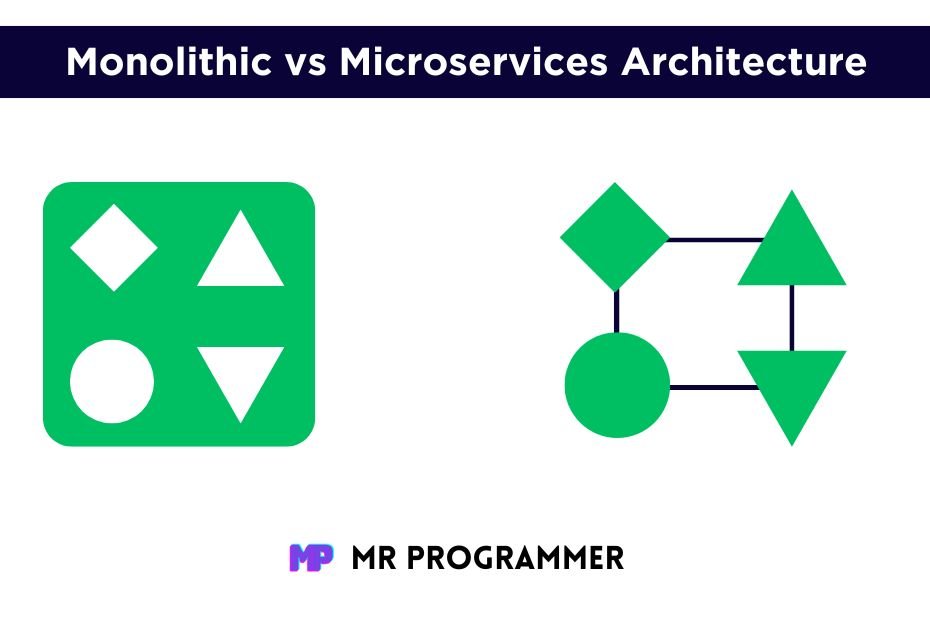Software architecture is the prototype of a building – it defines how different components of a software system are organized and interact with each other. A well-structured software architecture is crucial for the success of any application. In today’s tech landscape, two main architectural styles are used: Monolithic and Microservices.
Table of Contents
Also Read: SRE vs DevOps Revealing: Differences, Salaries, and More
In this blog post, we’ll explore the difficulties of both Monolithic and Microservices architectures and discuss which one might be better suited for modern applications. However, it’s important to note that there is no one-size-fits-all solution, the choice between the two depends on various factors unique to each project.
What is Monolithic Architecture?
Monolithic architecture is like a block where all the components of an application are tightly integrated and work together. It’s characterized by its simplicity in development and deployment, making it a popular choice for smaller projects or applications with straightforward requirements.
Advantages of Monolithic Architecture
Some advantages of using Monolithic Architecture include:
- Simplicity in development and deployment: With all components bundled together, it’s easier to develop and deploy a monolithic application.
- Easier data consistency management: Since all data operations are performed within the same application instance, maintaining data consistency is relatively straightforward.
- Potentially faster performance for smaller applications: In certain cases, the lack of network overhead in communication between components can result in faster performance.
Disadvantages of Monolithic Architecture
Monolithic Architecture also has some disadvantages which include:
- Difficulty in scaling: As the application grows, scaling becomes challenging since all components need to scale together.
- Tight coupling leads to slower development cycles: Changes in one part of the application may require modifications across the entire system, leading to slower development cycles.
- Limited technology stack flexibility: Since all components share the same technology stack, it might be challenging to adopt new technologies or frameworks.
Also Read: What is System Design? An Introduction to System Design
What is Microservices Architecture?
Microservices architecture, on the other hand, is like a network of interconnected, independent modules, each responsible for a specific business function. It’s characterized by its scalability and flexibility, making it an ideal choice for large, complex applications.
Advantages of Microservices Architecture
Some advantages of using Microservices Architecture include:
- Scalability and independent deployment of services: Each microservice can be scaled independently, allowing for better resource utilization and improved performance.
- Faster development cycles due to loose coupling: Since each microservice is self-contained, teams can work on them independently, leading to faster development cycles.
- Flexibility in using different technologies for each service: Developers have the freedom to choose the best technology stack for each microservice, enabling them to leverage the strengths of different technologies.
Disadvantages of Microservices Architecture
Microservices Architecture also has some disadvantages which include:
- Increased complexity in development and deployment: Managing a network of microservices requires smooth infrastructure and deployment strategies, adding complexity to the development process.
- Potential challenges in data consistency across services: Ensuring data consistency across multiple microservices can be challenging and requires careful planning and implementation.
- Requires robust communication and monitoring infrastructure: Effective communication and monitoring between microservices are essential for maintaining system reliability and performance.
Which Architecture to Choose?
When choosing between Monolithic and Microservices architecture, several factors should be kept in mind:
- Project size and complexity: Smaller projects with straightforward requirements may benefit from a monolithic architecture, while larger, more complex projects might require the flexibility of microservices.
- Growth and Scalability Needs: If you want to scale and grow your application, microservices architecture might be the better option.
- Team size and skillset: The size and expertise of the development team can also influence the choice of architecture, as microservices require a higher level of coordination and expertise.
Here is a table to summarize the key considerations:
| Consideration | Monolithic Architecture | Microservices Architecture |
|---|---|---|
| Project Size and Complexity | Smaller, simpler projects | Larger, more complex projects |
| Growth and Scalability | Limited scalability | Highly scalable |
| Team Size and Skillset | Small teams with limited expertise | Larger teams with diverse skill sets |
Conclusion
In conclusion, both Monolithic and Microservices architecture have their pros and cons, and the choice between the two depends on various factors such as project size, scalability needs, and team expertise. It’s essential to carefully evaluate these factors before deciding to ensure that the chosen architecture aligns with the project’s goals and requirements. Remember, there’s no one-size-fits-all solution – what works best for one project may not necessarily work for another
Ultimately, the goal of the software architecture is to provide a solid foundation for building reliable, scalable, and maintainable applications. By understanding the differences between Monolithic and Microservices architectures and choosing the right one for your project needs, you can become successful in today’s ever-evolving technological landscape.
- Introduction to Entrepreneurship: Everything You Need to Know Before You Start - June 12, 2025
- What Sets Artificial Intelligence Apart from Humans? - April 18, 2025
- Python Programming: A Comprehensive Guide for Beginners - March 27, 2025









One comment